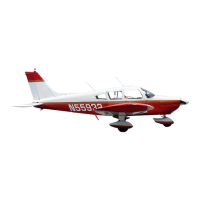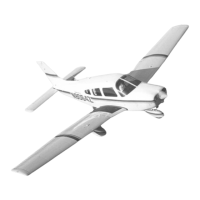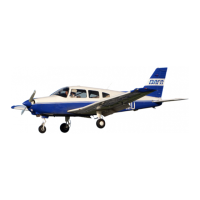CHEROKEE
WARRIOR
Intentional
spins
are
prohibited.
Maneuvering
at speeds in
excess of 124
mph must be
luvoided
in
order
to
prevent
overstressing
the airframe.
ENGINE
POWER LOSS
The most
common
cause
of engine
power
loss is mismanagement of fuel. Therefore, the
flrst step
to take after engrne
power
loss
is to move
the fuel selector to the tank not being used.
This rvill
often restore
power
even if
there is no apparent reason for the engine
to
stop
on
the
tank being used.
If
changing to another tank does not
restore
power:
I . Check fuel
pressure
-
if electric
fuel
pump
is
off,
turn it
ON.
2.
Push
mixture
control to full
RICH.
3. Check ignition switch. Turn to best
operating magneto
-
LEFT,
RIGHT, or BOTH.
APPROACH AND LANDING
Before
landing check list:
l. Seat backs
-
erect
2. Safety belts/harness
-
fastened
3.
Fuel
-
on
proper
tank
4. Electric fuel
pump
-
on
5. Mixture
-
full
rich
6. Flaps
-
set
(
I l5
MPH)*,
The airplane should be trimmed to
an
approach speed
of about
80MPH with flaps up.
The
flaps
can be lowered at
speeds
up tol
l5 MPH*,
if desired,
and the approach speed reduced
3
MPH for each
additional notch of flaps. Carburetor heat should not be applied unless there
is an
indication of
carburetor
icing, since
the use of carburetor heat causes
a reduction of
power
which
could be critical should a
goaround
be
necessary.
Full
throttle
operation
with
carburetor
heat
on is likely to cause detonation.
The amount of flap used during landings and the
speed of
the airplane at contact
with the
runway
should
be
varied
according to the landing surface, wind
conditions,
and airplane
loading.
It is
generally good practice
to contact the
ground
at the minimum
possible
safe speed
consistent with
existing conditions.
Normally, the best
technique
for
short and slow landings is to use full flap and enough
power
to maintain
the desired airspeed and approach flight
path.
Reduce the airspeed
during
flareout and
contact the
ground
at close to stalling speed. After
ground
contact hold
the nose
wheel
off as long as
possible.
As the
airplane slows
down,
drop the nose and apply the
brakes.
There
will
be less chance of skidding
the
tires
if the flaps are retracted
before applying the
brakes.
Braking is most effective when
back
pressure
is applied to the control
wheel,
putting
most of the
airplane
weight on
the main wheels.
In high
wind
conditions,
particularly
in strong
crosswinds.
it
may be desirable to
approach the
ground
at higher than normal speeds
with
partial
or
no
flaps.
*125
MPH
on serial nos. 7415001
throush 7515449.
OPERATING
INSTRUCTIONS
nrvtsnu
AP-m[
t6, tg76
7A

